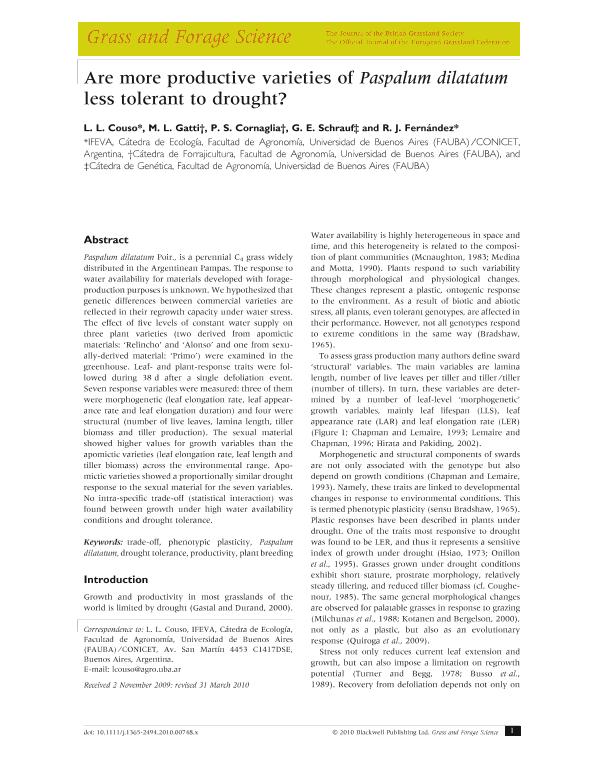Mostrar el registro sencillo del ítem
dc.contributor.author
Couso, Luciana Laura

dc.contributor.author
Gatti, María Laura

dc.contributor.author
Cornaglia, Patricia Susana

dc.contributor.author
Schrauf, Gustavo Enrique

dc.contributor.author
Fernandez Alduncin, Roberto Javier

dc.date.available
2019-03-11T20:35:29Z
dc.date.issued
2010-09
dc.identifier.citation
Couso, Luciana Laura; Gatti, María Laura; Cornaglia, Patricia Susana; Schrauf, Gustavo Enrique; Fernandez Alduncin, Roberto Javier; Are more productive varieties of Paspalum dilatatum less tolerant to drought?; Wiley Blackwell Publishing, Inc; Grass and Forage Science; 65; 3; 9-2010; 296-303
dc.identifier.issn
0142-5242
dc.identifier.uri
http://hdl.handle.net/11336/71422
dc.description.abstract
Paspalum dilatatum Poir., is a perennial C4 grass widely distributed in the Argentinean Pampas. The response to water availability for materials developed with forage-production purposes is unknown. We hypothesized that genetic differences between commercial varieties are reflected in their regrowth capacity under water stress. The effect of five levels of constant water supply on three plant varieties (two derived from apomictic materials: 'Relincho' and 'Alonso' and one from sexually-derived material: 'Primo') were examined in the greenhouse. Leaf- and plant-response traits were followed during 38 d after a single defoliation event. Seven response variables were measured: three of them were morphogenetic (leaf elongation rate, leaf appearance rate and leaf elongation duration) and four were structural (number of live leaves, lamina length, tiller biomass and tiller production). The sexual material showed higher values for growth variables than the apomictic varieties (leaf elongation rate, leaf length and tiller biomass) across the environmental range. Apomictic varieties showed a proportionally similar drought response to the sexual material for the seven variables. No intra-specific trade-off (statistical interaction) was found between growth under high water availability conditions and drought tolerance.
dc.format
application/pdf
dc.language.iso
eng
dc.publisher
Wiley Blackwell Publishing, Inc

dc.rights
info:eu-repo/semantics/openAccess
dc.rights.uri
https://creativecommons.org/licenses/by-nc-sa/2.5/ar/
dc.subject
Drought Tolerance
dc.subject
Paspalum Dilatatum
dc.subject
Phenotypic Plasticity
dc.subject
Plant Breeding
dc.subject
Productivity
dc.subject
Trade-Off
dc.subject.classification
Agricultura

dc.subject.classification
Agricultura, Silvicultura y Pesca

dc.subject.classification
CIENCIAS AGRÍCOLAS

dc.title
Are more productive varieties of Paspalum dilatatum less tolerant to drought?
dc.type
info:eu-repo/semantics/article
dc.type
info:ar-repo/semantics/artículo
dc.type
info:eu-repo/semantics/publishedVersion
dc.date.updated
2019-03-08T20:29:58Z
dc.journal.volume
65
dc.journal.number
3
dc.journal.pagination
296-303
dc.journal.pais
Reino Unido

dc.journal.ciudad
Londres
dc.description.fil
Fil: Couso, Luciana Laura. Consejo Nacional de Investigaciones Científicas y Técnicas. Oficina de Coordinación Administrativa Parque Centenario. Instituto de Investigaciones Fisiológicas y Ecológicas Vinculadas a la Agricultura. Universidad de Buenos Aires. Facultad de Agronomía; Argentina
dc.description.fil
Fil: Gatti, María Laura. Universidad de Buenos Aires. Facultad de Agronomía; Argentina
dc.description.fil
Fil: Cornaglia, Patricia Susana. Universidad de Buenos Aires. Facultad de Agronomía; Argentina
dc.description.fil
Fil: Schrauf, Gustavo Enrique. Universidad de Buenos Aires. Facultad de Agronomía; Argentina
dc.description.fil
Fil: Fernandez Alduncin, Roberto Javier. Consejo Nacional de Investigaciones Científicas y Técnicas. Oficina de Coordinación Administrativa Parque Centenario. Instituto de Investigaciones Fisiológicas y Ecológicas Vinculadas a la Agricultura. Universidad de Buenos Aires. Facultad de Agronomía; Argentina
dc.journal.title
Grass and Forage Science

dc.relation.alternativeid
info:eu-repo/semantics/altIdentifier/doi/http://dx.doi.org/10.1111/j.1365-2494.2010.00748.x
dc.relation.alternativeid
info:eu-repo/semantics/altIdentifier/url/https://onlinelibrary.wiley.com/doi/abs/10.1111/j.1365-2494.2010.00748.x
Archivos asociados
